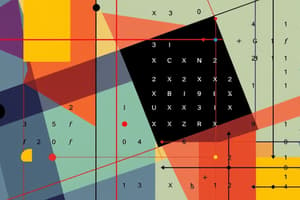Podcast
Questions and Answers
矩陣形式對於線性變換的表示有什麼優勢?
矩陣形式對於線性變換的表示有什麼優勢?
- 能夠很容易進行高斯消去法或矩陣求逆 (correct)
- 不需要考慮線性變換的特性
- 提供一種更抽象的理解
- 較難用於計算
在物理學中,線性變換通常用於表示什麼?
在物理學中,線性變換通常用於表示什麼?
- 物體的顏色和形狀
- 系統在空間中的位置
- 系統隨時間的演變 (correct)
- 物體的重量和體積
在計算機圖形學中,使用線性變換來做什麼?
在計算機圖形學中,使用線性變換來做什麼?
- 旋轉、縮放或調整圖像大小 (correct)
- 測量光的波長
- 改變字型和排版
- 調整音頻
在網絡分析中,PageRank算法使用什麼來對網頁進行排名?
在網絡分析中,PageRank算法使用什麼來對網頁進行排名?
何種表示形式允許對複雜系統行為進行深入洞察,但可能不太容易計算?
何種表示形式允許對複雜系統行為進行深入洞察,但可能不太容易計算?
Flashcards are hidden until you start studying
Study Notes
Linear Algebra: An Overview of Linear Transformations
Linear algebra is a branch of mathematics that deals with linear equations, vectors, matrices, and transformations between vector spaces. Among its various topics, the concept of linear transformations plays a significant role. Linear transformations represent fundamental concepts used in physics, computer science, engineering, and economics. In this article, we delve into the world of linear transformations, exploring their applications, properties, and representations.
Defining Linear Transformations
Linear transformations are functions that preserve the structure of vector spaces by maintaining the linearity property. They map vectors from one vector space to another while ensuring that the operations of addition and scalar multiplication are preserved. To fully understand linear transformations, consider their properties:
Properties of Linear Transformations
- Preservation of Addition: If two vectors
uandvin a vector space are added together, then their images under the transformationT(u + v) = T(u) + T(v). This means that the sum of vectors remains the same after applying the transformation. - Preservation of Scalar Multiplication: For any scalar value
α, if we multiply a vectoruwith the scalar, the image is also multiplied by the same factor, i.e.,T(αu) = αT(u). This ensures consistency when scaling vectors.
Representation of Linear Transformations
Linear transformations can be represented in various ways, including matrices and functional forms. Let's explore these representations:
Matrices
Matrices are commonly used to represent linear transformations due to their algebraic simplicity. In this representation, each row corresponds to an equation and each column represents a variable's coefficient. By performing row operations such as Gaussian elimination or matrix inversion, we can analyze and solve systems of linear equations.
Functional Forms
Functional forms provide a more abstract understanding of the transformation. These functions take into account the properties of linear transformations, allowing for powerful insights into the behavior of complex systems. However, they may not always be as straightforward to compute as matrix representations.
Applications of Linear Transformations
Linear transformations have numerous applications in various fields:
Physics
In quantum mechanics, linear transformations are used to represent the evolution of a system over time. These transformations provide valuable insights into the behavior and properties of physical systems.
Computer Graphics
Image processing involves linear transformations for tasks such as rotating, scaling, or resizing images. By understanding these transformations, we can create powerful algorithms for image manipulation and analysis.
Network Analysis
The PageRank algorithm uses eigenvalues and eigenvectors to rank web pages based on their connectivity and importance. This application demonstrates the power of linear algebra in solving complex problems found in network structures.
By studying linear transformations, mathematicians and scientists can unlock new discoveries and advance our comprehension of the world around us. The significance of this branch of mathematics is evident in its wide-ranging applications across diverse disciplines.
Studying That Suits You
Use AI to generate personalized quizzes and flashcards to suit your learning preferences.




